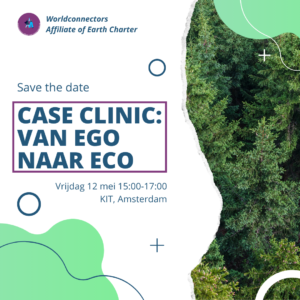On Friday, May 12, several Worldconnectors gathered at the KIT for the Ego2Eco case clinic, initiated and led by Lavinia Warnars. The purpose of the case clinic is to understand what eco-leadership means in theory and practice and how to motivate leaders to transition from an ego to an eco mindset. Lavinia begins with a brief introduction on the topic.
The pragmatic translation of the ethical principles of the Earth Charter is living within social and ecological boundaries, within the donut economy. These boundaries are defined by scientists like Kate Raworth and by nature and society themselves. Living within the donut economy requires a systematic shift. Eco-leadership encompasses the personal, psychological, and leadership changes necessary to achieve this systemic vision.
The Ego2Eco movement is committed to shifting from “wanting more of everything” to “doing more for all.” It’s about “being” and “we,” not about “having” and “I” alone. Central to the movement is the idea of connecting with each other, our surroundings, all life around us, and the landscape in which we are guests. Ego2Eco leadership shifts from denial, fear, and anger to eco-empowerment and maturity. It works toward creating a regenerative society for both humans and nature.
Examples of eco-leaders include Esther Ouwehand, Herman Wijffels, and Paul Polman. They aim to secure the future not only for ourselves and the planet but also for our economy and society as a whole. They think about future generations, including non-human species.
Following the introduction, some questions and comments are raised by the attendees.
- How does a circular approach fit into the transition from ego to eco, within the planetary boundaries?
Everything we use comes from nature, and we consume more energy than we realize. It’s inevitable that people who use a lot need to reduce their consumption. It’s a dynamic process with ongoing improvements.
- The current system facilitates ego leadership. Does the transition from ego to eco also bring about a system change, or does the system need to change first for ego to eco to occur?
If many leaders undergo a transition from ego to eco, the system can change. Implementing eco-leadership within an inherently ego-based system will not work. It is the power of leaders to change the system, as the current system was created by humans. These leaders aren’t necessarily just classical leaders like CEOs. Pioneers can bring about significant change through their exemplary roles.
After the introduction about Ego2Eco leadership, the group breaks into smaller groups to discuss some of the questions listed below and then share outcomes and thoughts during the plenary feedback session.
- What is an eco-leader?
- How does one become an eco-leader?
- What is your vision of the ego-to-eco transition path?
- What feedback do you have on the model?
- How do we facilitate the transition from ego to eco for current and future leaders?
- What obstacles will we encounter, and what are the solutions?
The discussion focuses on the definition of an eco-leader. Eco-leadership is situational, whereas ego-leadership is a role. Leadership roles will vary in different situations. The various forces within a community can be utilized. Eco-leadership revolves around serving a community. Unlike the ego system that serves the prosperity of some individuals, the ecosystem serves the well-being of the community. These systems are incompatible because one is based on competition and the other on cooperation. Furthermore, it is necessary for the perception of leaders to change. In the current system, an ego leader is seen as a strong person, and this perception carries a form of reward. A service-oriented eco leader is no less strong, but our perception must change.
The transition path is a widely discussed topic within the breakout groups. The ego-to-eco transition path can happen if people in society stand up and take others along with them. This will require perseverance. It is noted that there is a difference between a leader and a boss. It may be that bosses need to be abolished, allowing more people to take on responsibilities.
Another idea is that nature is crucial in the transition path. Everyone must take responsibility for nature. Sweden is given as an example, where everyone has a right to nature, and thus everyone bears responsibility. It is suggested that everyone is a future leader and that this doesn’t necessarily need to be confined to formal leadership. The question is whether it is necessary to invest energy in current leaders or if this is wasted energy that could be spent getting other people into important positions. Local leadership and initiatives have a significant impact, but eco leadership doesn’t have to be only local.
In addition, initiatives that arise within communities need to be strengthened for the transition. Entrepreneurs currently focus on more, faster, bigger, etc., as this is what is rewarded within the current (tax) system. The risk of being an eco-leader should be smaller. One idea presented is to provide tax benefits for the wealthy when they invest money in funds that can be used for sustainable initiatives. Additionally, taxes should indeed be levied on the wealth of the richest to curb ego leadership.
Furthermore, legislation will be needed for the transition, such as regarding maximum income. The transition also comes from the stories told. Earth Charter Stories are cited as an example of stories linked to the principles of the Earth Charter.
It is noted that openness is crucial within the ecosystem. Being part of the ecosystem means addressing what you see going wrong, approaching people, asking for support when needed, and taking responsibility for the system.
The conversation concludes with a wonderful example of how a grassroots movement without ego leaders has made a difference, namely, the anti-nuclear weapon protests of the 1980s. It is expressed that we are not as powerless as we sometimes think; together, we can make a difference.



